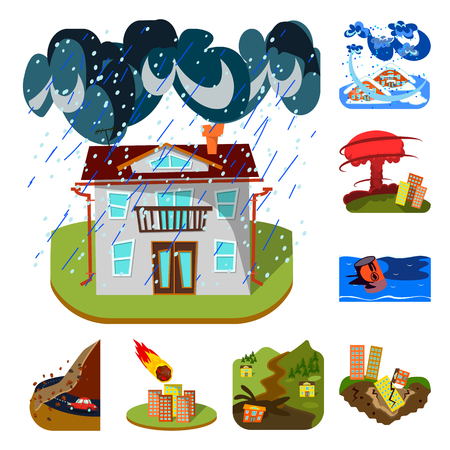Understanding Home Emergency Policies
When considering how best to protect your British home, it is crucial to understand the role of a home emergency policy. Unlike standard buildings and contents insurance, which typically cover damage or loss arising from incidents such as fire, theft, or flood, a home emergency policy specifically addresses urgent situations that require immediate attention. These can include boiler breakdowns during a cold snap, burst pipes, electrical failures, or even pest infestations. For many British households, rapid response is essential—especially during unpredictable UK weather conditions when heating and plumbing systems are under stress. A home emergency policy provides access to approved tradespeople at short notice, minimising disruption and further damage to your property. In essence, while your buildings and contents insurance is designed to cover the cost of repair or replacement after an incident has occurred, a home emergency policy focuses on swift intervention, ensuring safety and comfort for your family in the moment of crisis. This distinction makes it an invaluable addition for homeowners seeking comprehensive protection tailored to the unique demands of British homes.
2. Coverage Essentials for UK-Specific Emergencies
When choosing a home emergency policy, it is crucial to ensure the policy addresses emergencies that are particularly common in British households. The unpredictable UK climate and the unique features of British homes mean that certain issues arise more frequently than others. Here are the key emergencies you should expect your policy to cover, along with an overview of typical inclusions:
| Emergency Type | Typical Risks in UK Homes | What Good Policies Should Cover |
|---|---|---|
| Boiler Breakdowns | Central heating failures, loss of hot water (especially critical during winter months) | 24/7 call-out, repairs or replacement up to a set limit, annual boiler service (sometimes as an add-on) |
| Burst Pipes | Water damage from freezing or ageing pipes, risk heightened by cold snaps | Immediate repairs to stop leaks, damage limitation, possible alternative accommodation if severe |
| Electrical Failures | Total power loss, faulty wiring leading to safety risks or appliance failure | Call-outs for urgent electrical repairs, restoration of essential power supply systems |
| Pest Infestations | Rats, mice, wasps nests—particularly in older properties and terraces | Pest control visits, removal treatments for common household pests, sometimes with limits on repeat call-outs |
British weather patterns and traditional housing structures make these emergencies especially relevant. For example, older UK homes are more prone to plumbing and electrical faults due to legacy systems. Similarly, the colder climate increases reliance on boilers and central heating. When reviewing policies, confirm whether they provide comprehensive assistance for these issues—including 24-hour helplines, quick response times, and cover for both call-out charges and repairs. Some policies may also offer cover for lost keys or roof damage caused by storms; these can be valuable extras depending on your property type and location.

3. Response Time and Availability
When considering a home emergency policy in the UK, response time and service availability are critical factors. Emergencies such as burst pipes or electrical failures rarely occur at convenient times, so a reliable policy should provide a 24/7 helpline. This ensures that, no matter the hour or day—including weekends and bank holidays—you can access immediate assistance. Rapid response is particularly important during winter, when issues like heating breakdowns can quickly become serious.
Guaranteed Response Times
Not all policies offer the same speed of response. Some insurers guarantee that an engineer will attend within a specified timeframe—often within two to four hours for severe emergencies. When comparing policies, look for clear commitments on response times. This assurance can be invaluable, especially if you have vulnerable household members such as young children or elderly relatives, where delays could have significant consequences.
Availability of Approved Local Tradespeople
The quality and reliability of tradespeople dispatched to your home are just as important as their speed. Top-rated home emergency policies maintain networks of approved local tradespeople, ensuring that only qualified professionals attend your property. Using local engineers not only speeds up arrival times but also supports compliance with British safety standards and regulations.
Cost-Benefit Analysis
While policies with robust 24/7 support and rapid response guarantees may come at a slightly higher premium, the potential costs of property damage or prolonged discomfort far outweigh these extra charges. Investing in a comprehensive emergency policy ultimately offers greater peace of mind and can help avoid unexpected repair bills.
4. Limits, Exclusions and Excesses
When choosing a home emergency policy in the UK, its crucial to understand the fine print regarding limits, exclusions, and excesses. These factors determine not only what is covered, but also how much you might have to pay out of pocket in different scenarios.
Policy Limits: Call-Out Charges and Repairs
Most British home emergency policies set strict limits on the amount they will pay for each call-out or repair. For example, a typical policy may cap call-out charges at £500 per incident or restrict the number of claims you can make annually. It’s essential to check these figures as exceeding the limit means you’ll have to cover any extra costs yourself.
| Feature | Typical Limit | Example Scenario |
|---|---|---|
| Maximum call-out charge per claim | £200 – £500 | Plumber visit for burst pipe capped at £300; additional costs paid by homeowner |
| Total annual claim limit | £1,000 – £2,000 | If you reach £2,000 in claims within a year, further emergencies may not be covered |
| Number of call-outs allowed per year | 2-5 times | You’ve used your 5 allowed call-outs; sixth incident not covered |
Common Exclusions: What Isn’t Covered?
Exclusions are conditions or events that your policy will not cover. For British homes, common exclusions include:
- Wear and Tear: Gradual deterioration (e.g., ageing boilers) is typically excluded. Sudden breakdowns may be covered, but ongoing maintenance issues are not.
- Lack of Maintenance: If an emergency arises due to poor upkeep (like blocked drains from neglect), the insurer can decline the claim.
- Pre-existing Problems: Issues present before the policy start date are generally not covered.
- Non-domestic Use: Policies usually only apply to standard residential properties, not holiday lets or business premises.
The Cost Structure: Understanding Excess Fees
An excess is the amount you pay towards a claim before your insurer covers the rest. Excess fees help keep premiums lower but can add up if you need multiple repairs over a short period. Typical excess amounts range from £25 to £100 per claim in the UK.
| Provider Example | Excess Fee Per Claim | Total Payable (if three claims) |
|---|---|---|
| Axa Home Emergency Cover | £60 | £180 total for three emergencies in one year |
| Bristol Direct Policy | No excess (higher premium) | No additional cost per claim, but higher annual premium paid upfront |
| Saga Home Emergency Insurance (for over-50s) | £50 | £150 if claiming three times in a year |
Key Takeaway:
Always scrutinise your policy documents for limits on payouts and repairs, check what’s specifically excluded—especially regarding wear and tear—and factor in any excess fees when comparing policies for your British home. This ensures you avoid unexpected costs during an emergency and select cover that truly meets your needs.
5. Optional Extras and Add-Ons
When evaluating a home emergency policy, UK homeowners and renters should pay attention to optional extras and add-ons that can significantly enhance protection and convenience. These features are particularly valuable in the context of British homes, which often have unique needs due to varying property types and weather conditions.
Locksmith Services
Being locked out is a common scenario, especially in older British properties with traditional locks. Many standard policies may not include locksmith services as a default feature, so it’s wise to check if this is available as an add-on. This can save both time and money, sparing you the expense of calling out a private locksmith during an emergency.
Alternative Accommodation Cover
Should a major incident render your home temporarily uninhabitable—such as severe flooding or a boiler breakdown—some policies offer alternative accommodation cover. This means your insurer will arrange and fund suitable temporary housing while repairs are underway. For families or those with pets, verify if the policy covers everyone’s needs, as costs for extended stays can quickly add up.
Outbuildings and External Structures
Britisth properties often feature sheds, garages, greenhouses, or even garden offices. Standard home emergency cover may exclude these outbuildings by default. Opting for an add-on that extends coverage to external structures ensures that damage to these spaces—whether from burst pipes, vandalism, or storm damage—is also covered, reducing potential repair costs.
Tailoring Your Policy
When selecting add-ons, assess your household’s specific requirements. For example, if you store valuable tools in a shed or run a business from a garden office, ensuring these areas are protected makes sound financial sense. Similarly, consider the likelihood of needing temporary accommodation based on your property’s age and location.
Cost-Benefit Analysis
While optional extras increase the premium slightly, they can result in substantial savings during emergencies by avoiding unexpected out-of-pocket expenses. Always compare the additional cost against the potential risk and inconvenience of not having adequate cover in place.
6. Cost Analysis and Value for Money
When selecting a home emergency policy, understanding the balance between cost and coverage is crucial for British homeowners. The aim is to ensure that the policy offers genuine value for money in relation to typical repair expenses encountered in UK homes.
Comparing Policy Premiums with Common Emergency Costs
It’s wise to compare annual premiums of home emergency policies with the average costs of common household repairs in Britain. For example, an emergency plumber call-out can exceed £150, while boiler repairs or replacements may cost several hundred pounds or more. Evaluate whether the annual premium (often between £50 and £200) covers likely scenarios such as burst pipes, broken heating systems, or electrical failures.
Assessing Excess Fees and Claim Limits
Look closely at policy excess fees – the amount you pay towards each claim – and total claim limits per incident or per year. A lower premium may seem attractive but could be offset by high excess fees or restrictive limits, meaning you cover a significant portion of the repair yourself. Aim for a policy where excesses and caps align realistically with potential repair bills.
Factoring in Additional Benefits
Some policies include extras such as annual boiler servicing or pest control. Consider whether these add tangible value relative to their standalone costs. While bundled services can increase upfront premiums, they may save money over time if you routinely require these services.
Identifying True Value-for-Money Options
To identify the most cost-effective choice, calculate the total likely outlay (premium plus any expected excess payments) against your property’s risk profile and past history of emergencies. Policies offering reasonable premiums, transparent terms, comprehensive cover, and practical claim limits usually represent the best value for British households seeking peace of mind without overspending.


